YYYYMMDD >>> BACK HOME <<< >>> SELECTED FEATURES <<< >>> INTERVIEWS <<<
[20231221]
LITHIUM SEX DEMONS IN THE FACTORY by CANDICE LIN at CANAL PROJECTS commissioned by CANAL PROJECTS and THE 14TH GWANGJU BIENNALE [from 20230922 to 20231216]
[Photos: Izzy Leung] [Courtesy the artist and François Ghebaly Gallery. Commissioned by Canal Projects and the 14th Gwangju Biennale / Image courtesy Canal Projects]


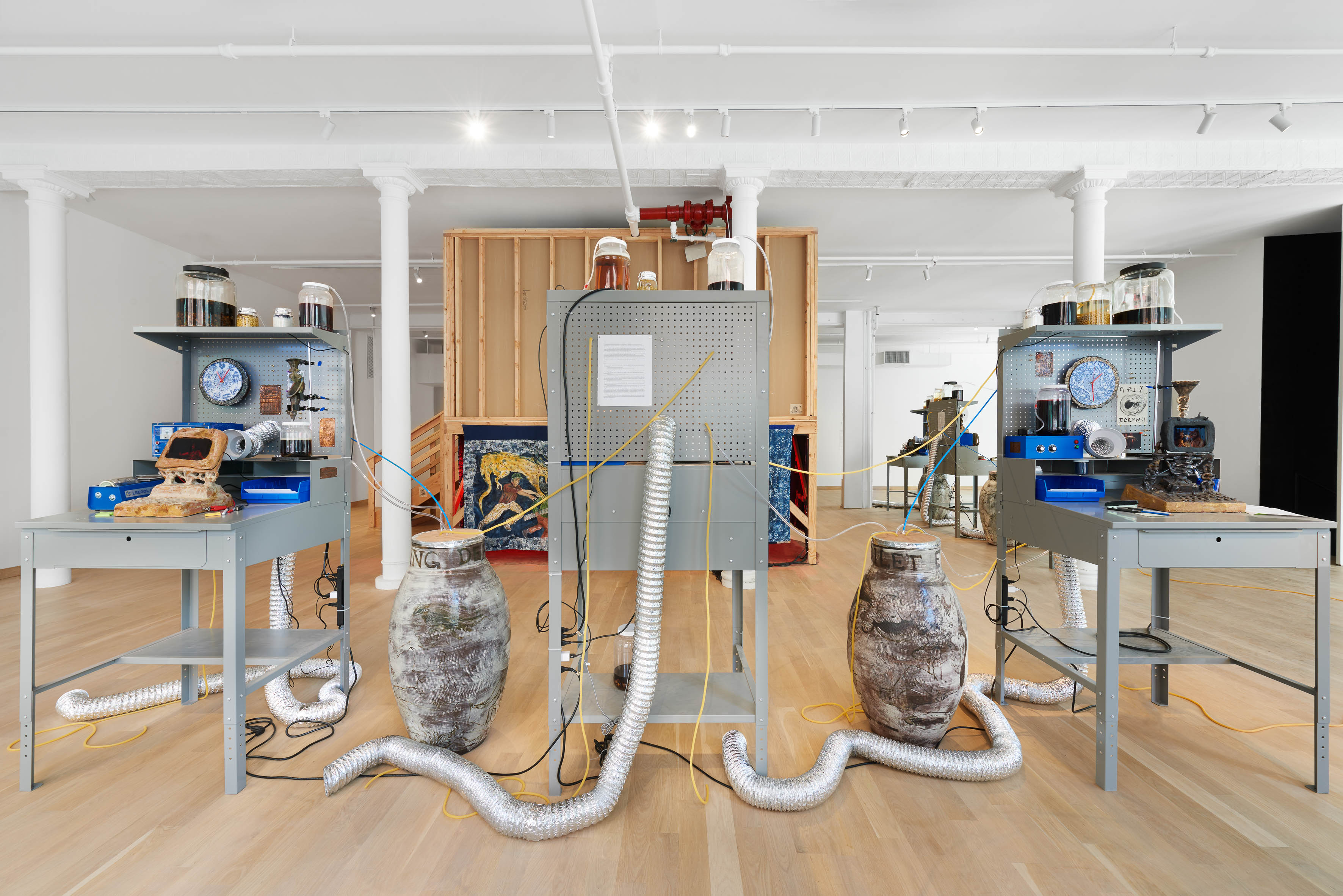






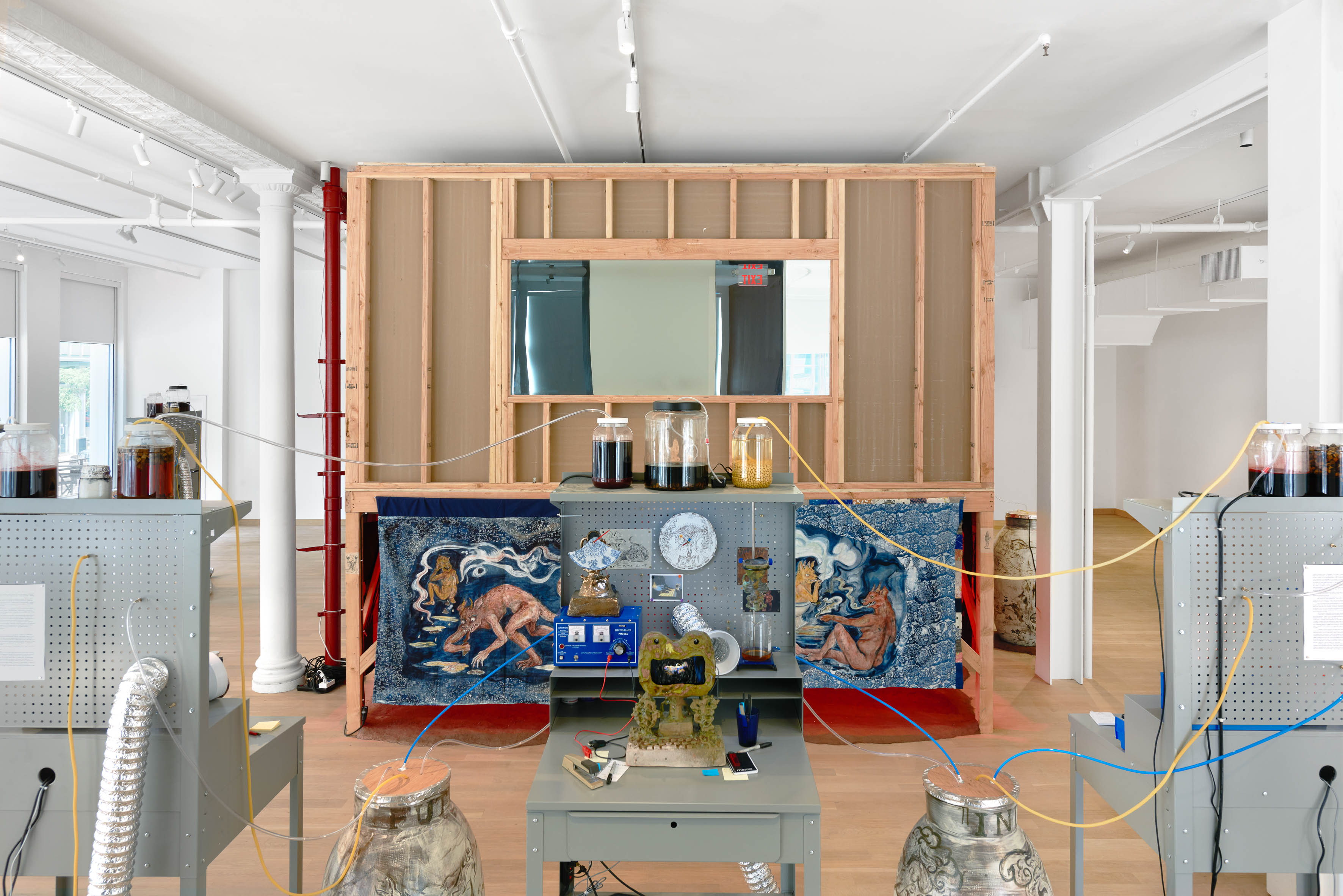
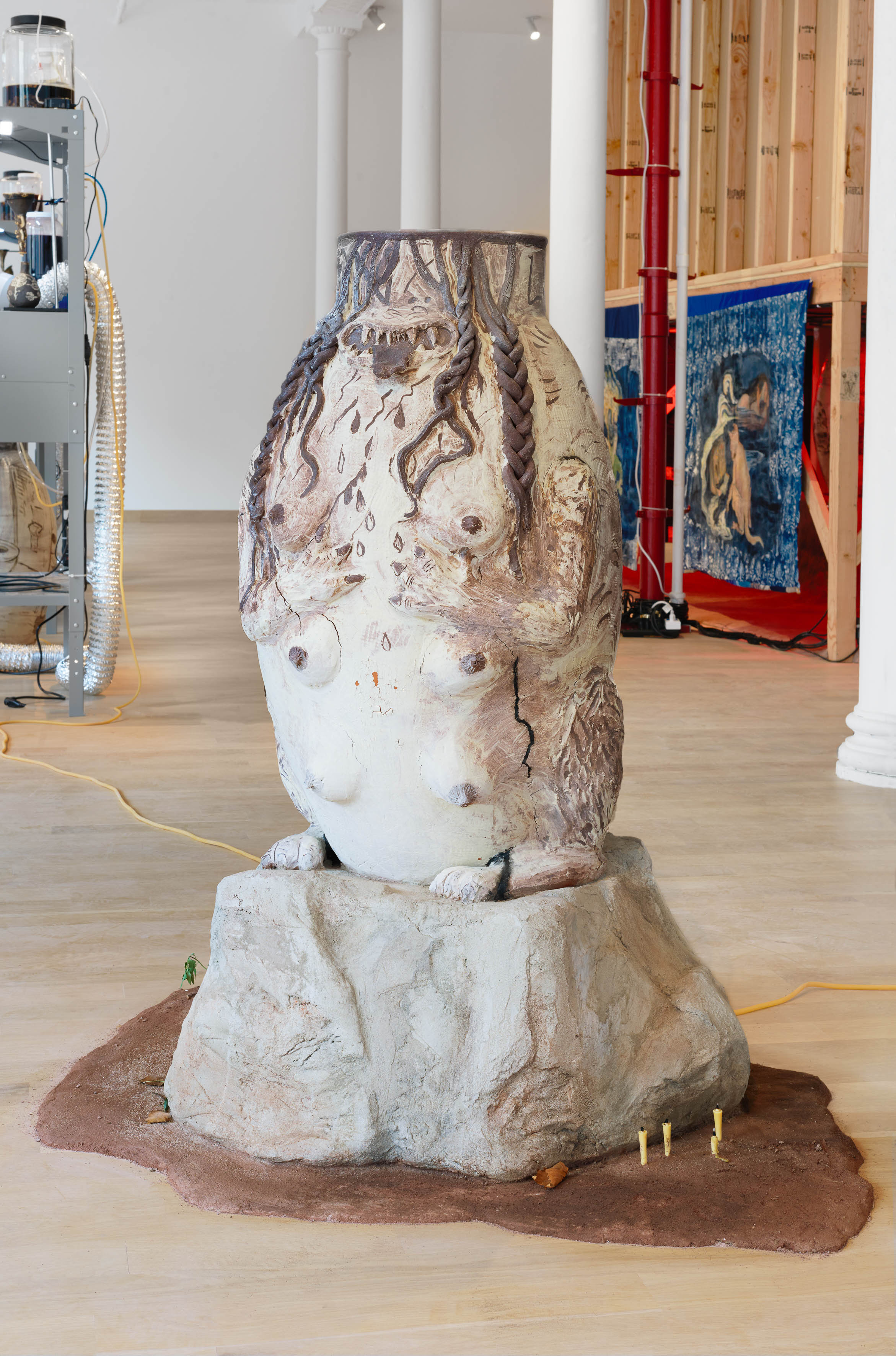

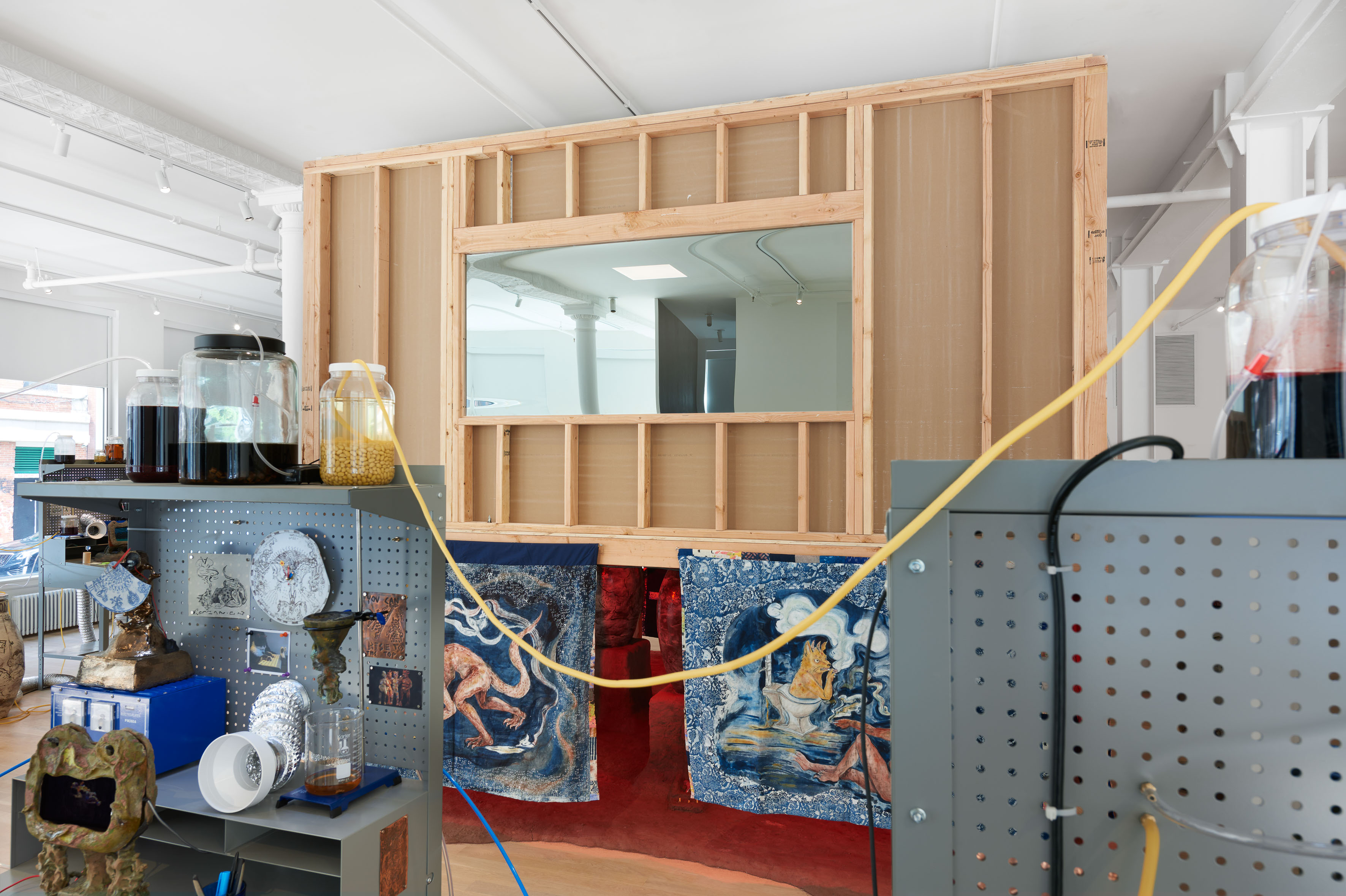
















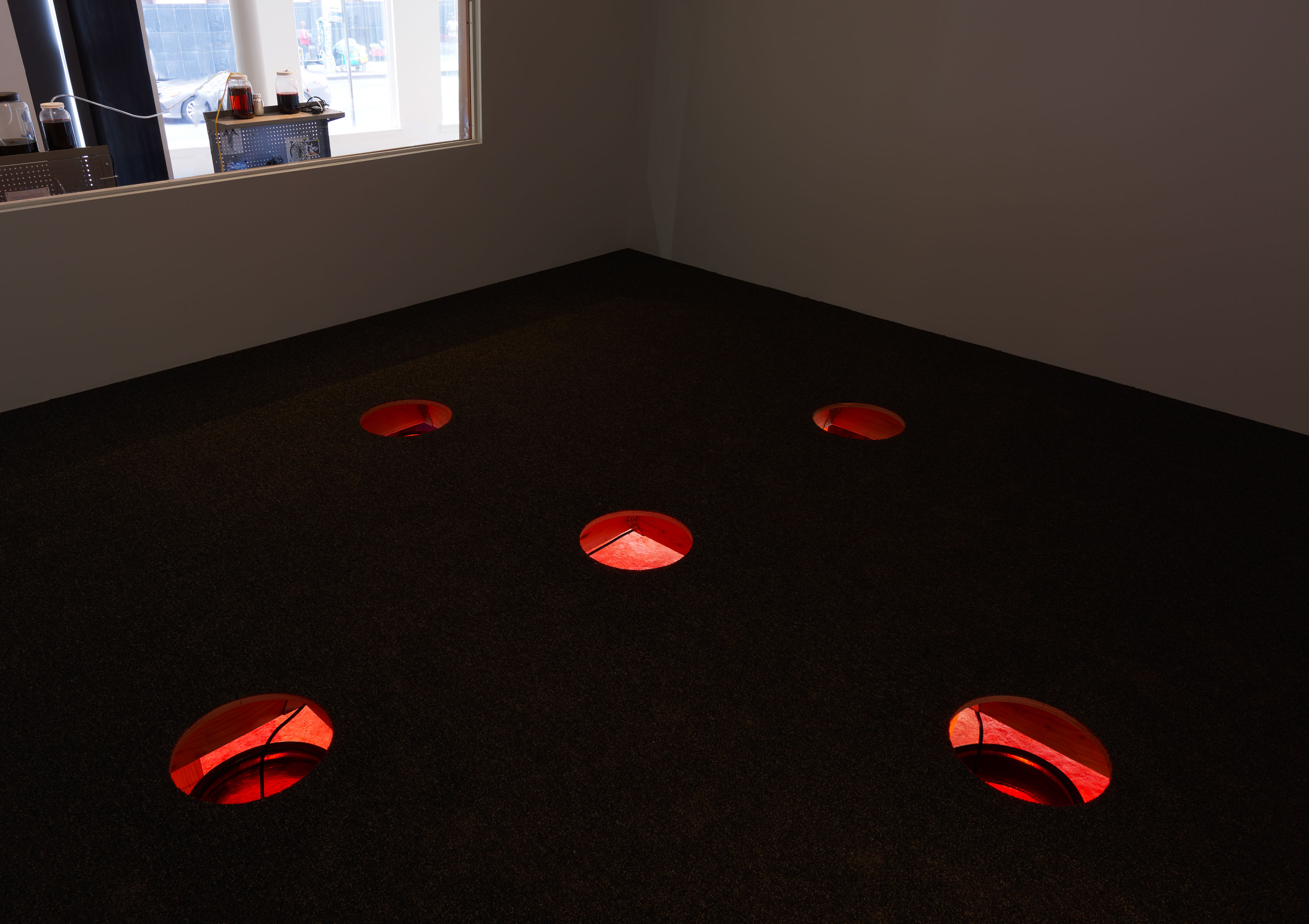

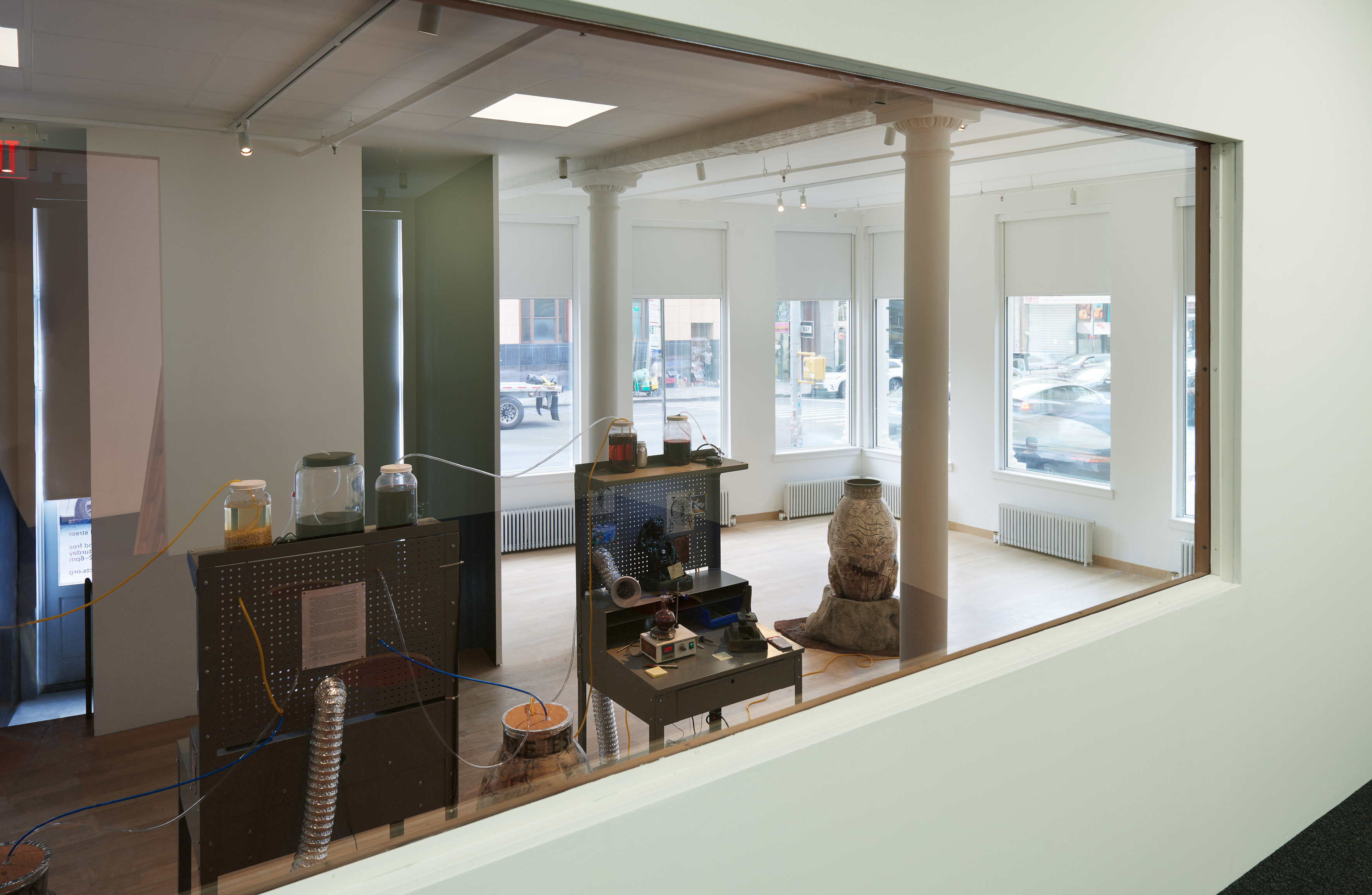

Canal Projects is pleased to present the first New York solo institutional exhibition of Los Angeles-based artist Candice Lin, Lithium Sex Demons in the Factory (September 22–December 16, 2023). Co-commissioned by Canal Projects and the 14th Gwangju Biennale, the site-specific project replicates a lithium battery factory, continuing the artist’s ongoing research on globalization and trade networks, materiality, and labor.
Emulating a precarious site of manufacture, Lithium Sex Demons in the Factory features a large platform at the center of the gallery at Canal Projects, creating a vantage point from where visitors take on the surveillance gaze of a factory manager. Touching on a complex web of issues that relate to the histories of mass production, the installation focuses on the extraction and production of lithium––a mineral that powers global mass consumption and is also used in ceramic production.
On the ground, ceramic fermentation vessels are connected by tubing to six manufacturing workstations that are mounted with ceramic computers and time clocks, whirring machines, and flickering motion-activated lights. At each workstation, sound, video animation, and text narrate the fictional lives of the lithium sex demons. Their story is based on a short essay written by Lin, describing a sex demon’s quest to return from the dead to their lover in a lithium battery factory. Set among the fumes of soldering smoke, the videos depict the banality of an assembly line possessed with dreams and passions that refuse to die.
The story of the sex demon is a fiction that draws from various Asian myths and ghost lore, such as the Chinese hungry ghosts (èguǐ), Japanese shit-eating ghosts (gaki), and Malay penanggal that feast on menstrual blood. The demonic possession of factory workers has a basis in reality, as documented by the scholar Aihwa Ong. In Lin’s work, however, these testimonies of toxicity become entwined with a story of bodily desire in the spiritual world, creating multiple layers around labor politics, queer love, and the materiality of our contemporary world.
[Text: Canal Projects]
Toxicity and resistance in Candice Lin’s Lithium Sex Demons in the Factory
At the center of Candice Lin’s newest site-specific installation, Lithium Sex Demons in the Factory (2023), lies the “manager’s office.” This elevated platform provides a vantage point from which visitors can take on the surveillance gaze of a factory supervisor. Despite being brightly lit, the office is constrictive. The short ceiling curtails the sense of power that one is supposed to adopt when occupying the space. A window fitted with a one-way mirror looks onto the ground floor of Canal Projects where six industrial workstations imitate the desks of lithium battery manufacturers. Each workstation contains laboratory equipment including glass beakers, tumblers, boiling flasks, scales, and jars filled with liquid concoctions. The liquids flow through tubing that emerge from onggis, traditional Korean ceramic fermentation vessels, and cut over the workstations which are filled with time clocks, whirring machines, and flickering motion-activated lights. On top of gray metal stations, ceramic computers containing video animations narrate the fictional lives of the lithium sex demons –specifically one cat-demon’s quest to return from the dead to their lover in the battery factory.
Candice Lin’s attention to the materiality of mass production of ceramics and lithium in this installation allows her to weave together many worlds of signification. Her phantasmal lithium factory looks, sounds, and feels, like an al-chemical laboratory where the traditional and the modern collide. Altogether, this collision blurs the lines between the custom-made and the mass-produced, and between mysticism and science, in ways that unsettle how we come to understand capitalism’s handling of labor, commodity production, and gender relations. Drawing on both historical and fictional accounts, the project interrogates lithium battery manufacturing through a particular attention to the paranormal where spectral phenomena emerges to fissure the logic of advanced capitalism and its forceful systems of subjectivation.1
1 I use the concept of refusal here following the writings of Dixa Ramírez, Colonial Phantoms. Belonging and Refusal in the Dominican Americas, from the 19th Century to the Present (New York: New York University Press, 2018); and Audra Simpson, “On Ethnographic Refusal: Indigeneity, ‘Voice’ and Colonial Citizenship,” Junctures 9 (December 2007); 67-80. According to them, refusal indicates the capacity to reclaim language in a way that regenerates the social relationships that are negated or disavowed in colonial representations of modes of understanding the so-called other.
Since the 1970s, anthropologist Aihwa Ong has collected and analyzed a wide range of testimonies related to demonic apparitions, ghostly encounters, or spectral presences that have been primarily reported by female workers employed by electronic factories in Asia. In a seminole study of this phenomena, Ong noted that:
…workers pointed to the effect of the steady hum and the factory pollutants, which permanently disturbed graveyard spirits. Unleashed, these vengeful beings were seen to threaten women for transgressing into the zone between the human and nonhuman world, as well as modern spaces formerly the domain of men.2
2 Aihwa Ong, “The Production of Possession: Spirits and the Multinational Corporation in Malaysia,” American Ethnologist 15, no. 1 (February 1988): 34.
The accounts demonic apparitions coincides with the harsh, restrictive, and often oppressive working conditions inside the factories. However, as Ong’s study also showed, the testimonies are often dismissed as simple expressions of female hysteria or medical malaise.3
3 Ong, “The Production of Possession: Spirits and the Multinational Corporation in Malaysia,” 29. And yet, theorists of capitalism, colonialism, and gender relations such as Michele Foucault, Antonio Gramsci, Sylvia Wynter, and others have often discussed the fact that paranormal phenomena can be interpreted as methods for negotiating the ontological conditions of market alienation, as these schematas emerge precisely in scenarios where dispossessed workers have to grapple with the forces of dehumanization.
In that regard, Candice Lin’s installation tackles the factory as a site that contains both the alleged liberties of free market economies as well as its oppressive colonial corollaries. Explored through the subject position of female workers, Lin’s recreation of a manufacturing setting allows us to contend with the ways in which factories have
historically been sites of contestation.
While the western liberal project of the eighteenth-century sought to build factories under a logic of free-trade and emancipation by alleging that waged labor would equalize society, historian Lisa Lowe carefully describes the paradoxical
ways in which the development of industrialized work simultaneously structured the racialization of people under systems of servitude and slavery in Asia.4
4 Lisa Lowe, The Intimacies of Four Continents (Durham, Duke University Press), 1-41. As Lowe describes in her text The Intimacies of Four Continents, “while the promotion of liberty would appear to eradicate or vanquish despotic modes of governing, in the nineteenth century liberal tradition exemplified by [John Stuart] Mill, despotism was discussed not as counter to liberty, but as the very condition out of which liberty arises and the condition to which its integral and bound.”5
5 Lowe, The Intimacies of Four Continents, 15.Lowe further articulates how the liberal ideas of emancipation through industrialization became, in fact, the preconditions for the continuation of slavery whereby, “Liberty did not contradict colonial rule but rather accommodated both colonialism as territorial rule, and colonialism as the expansion of imperial trade in Asia.”6
6 Ibid. Lowe’s articulations illuminate that while free trade and its labor structures have signified freedom for some, liberal economic aspirations have been historically tied to the dispossession of others, those, who are in fact, deemed “unfit for liberty.”7
7 Ibid. It is thus not a coincidence that according to Ong the appearance of Taylorism and Fordist-like assembly-lines in south and southeast Asia in the 1970s also altered the social and economic fabric of peasants and rural communities.8
8 Ong, “The Production of Possession: Spirits and the Multinational Corporation in Malaysia,” 34-35.Marking both the time of capital and the disciplining of the subject, the development of factory-work rearticulated the relationship between natural resources, commodities, and workers. Under the assembly-line, these entities became inseparable and often interchangeable.9
9 Ibid.Decolonial scholar Anibal Quijano termed this paradigm the “colonial matrix of power,” ––a logic built on the ever-evolving instrumentalization of race, gender, and economic exploitation, in the service of the expanding mechanisations of colonial oppression.10
10 The “colonial matrix of power” (patron del poder colonial) is a concept elaborated by Aníbal Quijano that explains the various domains in which colonial power operates. According to Quijano the colonial matrix of power encompasses four different domains: “1) The appropriation of land and the exploitation of labor; 2) the control of authority (viceroyalty, colonial states, military structures); 3) The control of gender and sexuality (the Christian family, gender and sexual values and conduct); 4) The control of subjectivity (the Christian faith, secular idea of subject and citizen) and knowledge (the principles of theology structuring all forms of knowledge and concept of Reason structuring the human and natural science and the practical knowledge of professional schools.” For a detailed discussion on the colonial matrix of power see, Aníbal Quijano, “Colonalidad del poder y clasificación social,” en Cuestiones y horizontes: De la dependencia histórico-estructural a la colonialidad/decolonialidad del poder (Buenos Aires: CLASCO, 2014); Walter Mignolo, “Delinking. The Rhetoric of Modernity, the Logic of Coloniality and the Grammar of De-Coloniality,” Cultural Studies 21, no. 2 (March 2007): 477-478.
Lin’s interest in the symbolism around demons and ghosts within the ceramic vessels, video animations, and tapestries of this installation arises from the aforementioned scholarly study on the subject. In Lin’s approach to the demonic, however, testimonies of lithium toxicity become entwined with a fictional story of desire and transformation. The sex cat-demon in Lin’s work fictional narrative is a composite figure that draws from various Asian myths such as the èguǐ ––Chinese hungry ghosts, gaki––the Japanese shit-eating ghosts, and the Malay penanggal that feasts on menstrual blood. In the artist’s text titled “My Life as a Lithium Sex Demon,” edited and published online by Triple Canopy, the sex demon seeks love through toxicity, existentially questioning the bodily and spiritual limits of sex and desire. The story, animated for the installation at Canal Projects, plays inside the ceramic computers found on top of the workstations.
While referencing specific Malaysian, Chinese, and Buddhist demonic lores and their engagement with corpses, feces, and blood, Lin’s story also recalls the surrealist exploration of eroticism and the grotesque by the French avant-garde writer George Bataille (1897-1962). While perhaps only coincidentally, Bataille’s explorations into the ideas of aberrant sensuality resonate with Lin’s narrative of eroticism amidst bodily fluids, death, and transformation.11
11 George Bataille, Eroticism. Death and Sensuality, trans. Mary Dalwood (San Francisco: City Lights Books, 1986), 11. Lin’s animated story suspends us in the tension between life and death, civility and impropriety, that is similarly proposed in Bataille’s own exploration of the grotesque. According to the surrealist author, the confluence of eroticism and the grotesque questions, challenges, and even helps us to escape the strict rules defining human “civility.”12
12 Ibid. In Lin’s installation, the grotesque is replaced by the demonic, which is presented in the alleged aberrant eroticism of the sex demons. In one instance, the animation showcases the cat-demon contemplating a dead body. Intoxicated by lithium fumes, the demon is aroused and confused by death, proceeding to sensually thrust its hips and growl over the motionless and decomposing body. In the story, one lithium sex demon recounts that:
The humans use the lithium like oil, to power cars and phones and computers. The lithium steals our energy and gives it to the humans. No demon understands why or how. But we can use lithium like a time-travel device: when we eat the powder, we can slow time and enter the humans’ world. We’re not at full strength, though. And once we stop eating, the lithium fades out of our bodies; we can’t see the humans anymore and they can’t see us.13
13 Candice Lin, “My Life as a Lithium Sex Demon,” Triple Canopy, no. 28, True to Life, (August 16, 2023). https://canopycanopycanopy.com/contents/my-life-as-a-lithium-sex-demon
According to the narration we understand how the demons take on different states of becoming, subsuming every affective and material relationship in their own fungibility. They are transforming and being transformed by the different states of lithium, which changes from powder, to liquid, to energy power. In fact, as stated by curator Lotte Arndt about Candice Lin’s 2017 exhibition A Hard White Body, toxicity can still be read as a “a potential source of pleasure and radical decentering, even as its destructive effects impact bodies unequally.”14 The demon’s material relationship with the fumes thus becomes mutually constitutive. The toxicity and the labor of extractive manufacturing cannot be separated from the desires and intimacies of the subject positions that they produce.
While paranormal or mystical activity could, at first glance, be construed as being directly oppositional to the technocratic conditions of “modern” industrial work, the invocation of the demonic is rather one of ambiguity. Lithium Sex Demons in the Factory, therefore, proposes the demonic as a tool of distraction that signals a persistent interruption of hegemonic narratives.15 As Aihwa Ong argued, these sites often exude danger from both toxic substances as well as treatment of overseers, generating fear in ways that catalyze violent uprisings, irrational behavior, and fear of wickedness. Yet, in the factory spectrality is not necessarily a mode of resistance, nor is it emancipatory. Lin’s installation rests on ambivalence as a strategy that enables the demonic to unsettle the limitations imposed by capitalist-colonial systems.16 The demonic as an expression of anti-colonial ambivalence transforms not only states beyond the human, but deploys eroticism in places meant to eradicate all sense of intimacy, affect, and desire, as these allegedly do not belong within the mastery of productiveness established by assembly-line production.
When Candice Lin indicated to me that the lithium battery factory of her installation was to appear possessed, I understood that the factory did not only host demons, but that the entire infrastructure was in and of itself demonic. The surveilling perspective of the manager’s office is designed to make participants complicit with the gaze of the overseer and by default make them witness the demonic taking possession. By way of this vantage point, the demonic is to be contended with, so that by looking down through the one-way mirror onto the workstations, the viewer sees in hauntingly plain sight what nineteenth-century imperial regimes relegated to the margins, to the Other. The demonic in Lithium Sex Demons in the Factory presents us with testimonials of these strategies and struggles, not only in the awareness of the accounts of factory workers, but also in the understanding that the recourse to the demonic enacts a strategy of uncertainty and refusal adequate for the creation of alternative knowledges and intimacies –a knowable world that lies outside the boundaries of western objectivity, science, and mechanical efficiency.
[Text: Sara Garzón]
©YYYYMMDD All content and design by Daniela Grabosch + Ricardo Almeida Roque unless otherwise stated. Images, Videos and Texts can only be used under permission of the author(s).